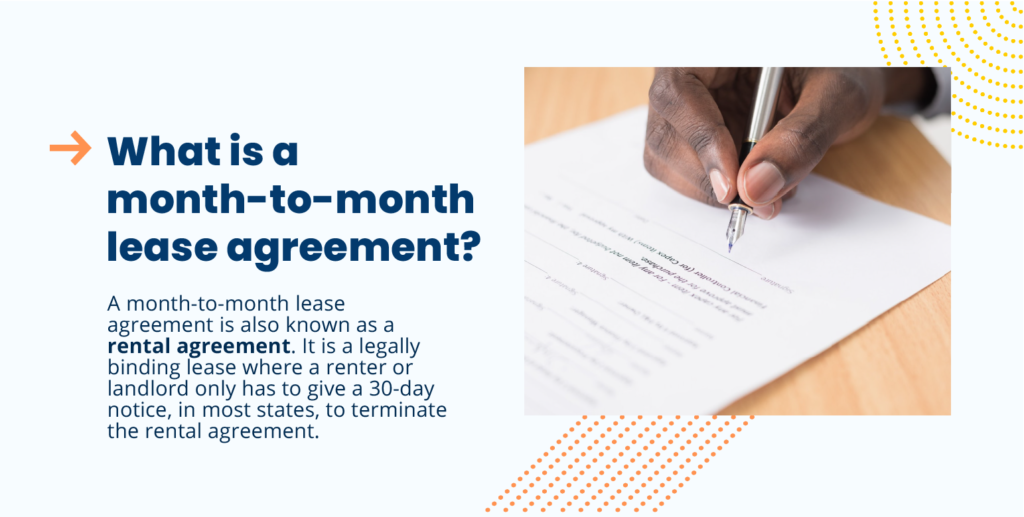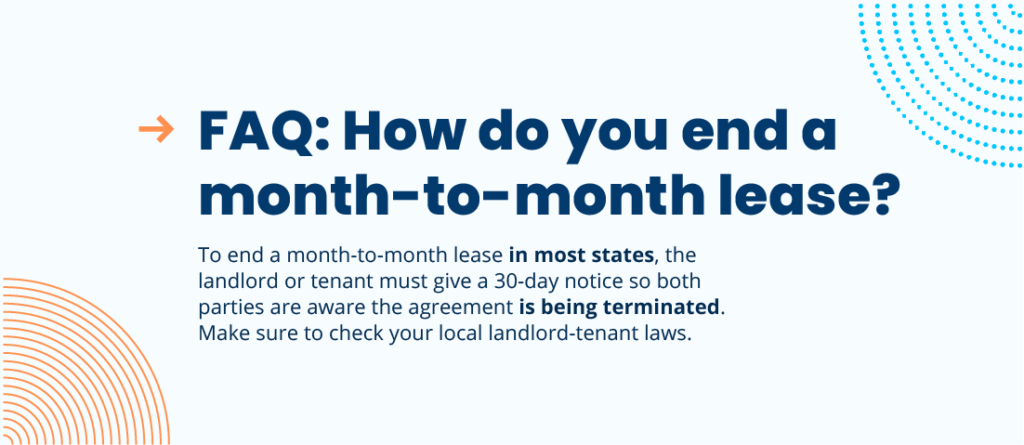14 min read
IRS Rules for Rental Property: Landlord Tax Guide for 2025
Staying compliant with IRS rules for rental property is a non-negotiable piece of the landlord puzzle. As we all know, Uncle Sam expects full transparency from...

When property investors buy a rental, they typically already know the type of property it will be: long-term or short-term. But, it’s just as important to know the type and length of lease agreement you will offer and accept. Depending on your property investment strategy, choosing to accept a month-to-month lease agreement could match your goals more than a long-term lease ever could.
Both types have many benefits as well as a few drawbacks for renters and landlords alike. To decide if a month-to-month lease agreement is right for you, keep reading as the TurboTenant team guide you through what it means, the pros and cons, and how to create your own.

A month-to-month lease agreement is a legally binding lease where a renter or landlord only has to give a 30-day notice to terminate the lease agreement – in most instances. (Some states may require more or less than 30 days.) Unlike a long-term lease agreement, which is typically set for six months to a year or more, month-to-month leases help create more flexibility, making them ideal for certain situations.
For example, it’s common for renters who were previously on a long-term rental agreement to extend their lease agreement for a month or more before they plan to officially move out. For more details about the differences between lease vs. rent, read our guide.

Sometimes renters need flexibility and do not want to sign a full long-term lease renewal. On the flip side, landlords might not want to fill their property with a long-term tenant for certain reasons like future renovations. That’s where a month-to-month lease agreement comes in as the perfect solution for both parties. Here are the main benefits for both landlords and renters:
There are a few cons when it comes to a month-to-month lease agreement. Ultimately, it comes down to the fact that they are less stable and uncertain which can impact landlords and renters differently.
For landlords, the uncertainty that a tenant could end the agreement with only 30 days’ notice (depending on the state) gives you a shorter time frame to find a replacement tenant. Even if the rent is higher for a month-to-month lease agreement, it still leads to having a less stable monthly rent cash flow. A long-term lease renewal eliminates the risk of potential income loss by having a set term for possibly a year or longer and gives you more time to find another tenant.
For renters, a potential drawback would be the more expensive rent price and also the landlord’s ability to end the agreement at any time. For renters seeking flexibility, this could be a good thing, but for those who want more security, opting for a longer-term rental agreement is a better way to go.
Even though in most states a month-to-month lease agreement only needs 30 days’ notice to be ended, it’s essential to get the agreement in writing. Having a verbal agreement can lead to sticky situations, which is why it’s best for landlords to create a lease agreement to protect themselves and their investment.
Your month-to-month lease agreement will essentially be the same as a standard long-term lease agreement with the exception of the length of the lease and what’s required to give notice to end the agreement. Luckily, with TurboTenant, you can create a customizable state-specific lease agreement where you can select the lease terms to either be fixed or month-to-month.

Once you have filled out your lease agreement, you will conveniently be able to send it out for e-signatures. Once it is signed by you and your tenants, it is legally binding and will be safely stored in your account. Remember, in most states to end a month-to-month lease agreement, the landlord or tenant must give a 30-day written notice. Be sure to always check the specific laws in your state regarding month-to-month lease agreements.
A month-to-month lease agreement can be a great choice for renters and landlords who want to keep their options open. To decide if it would be right for you as a landlord, determine your long-term goals and future projects, and always assess your financial standing so you can protect your investment and ROI. Log in to TurboTenant, or sign up for free so you can create your month-to-month lease agreement.

To end a month-to-month lease in most states, the landlord or tenant must give a 30-day notice so both parties are aware the agreement is being terminated. While this can vary, make sure to check your local landlord-tenant laws, and read here for more details on how to properly send a notice to vacate.
A long-term lease and a month-to-month rental agreement both have different pros and cons as it depends on your situation as a renter and a landlord. If you are looking for more flexibility as a renter, a month-to-month could be a great option. As a landlord, if you want more of a consistent and confirmed long-term tenant, then opting for a longer lease agreement might work better for you. Determine what your goals are with renting and as a rental investor and then decide which one would work best for you.
Month-to-month lease agreements can be more expensive rent-wise because they are more temporary and can end at any time. Landlords will often charge a higher rate as they are taking on more risk to have a shorter-term tenant. It could take landlords more time to fill the vacancy when a month-to-month tenant ends the agreement, which could mean less of a consistent cash flow.
14 min read
Staying compliant with IRS rules for rental property is a non-negotiable piece of the landlord puzzle. As we all know, Uncle Sam expects full transparency from...
10 min read
If you’re a new real estate investor, you might ask yourself, “Can the IRS find out about my rental income?” The answer...
14 min read
Managing a tenant not paying rent is a frustrating and challenging experience for landlords. It’s especially true if you rely on the...
Join the 700,000+ independent landlords who rely on TurboTenant to create welcoming rental experiences.
No tricks or trials to worry about. So what’s the harm? Try it today!
TurboTenant, Inc., © 2025
Created in Sunny Colorado